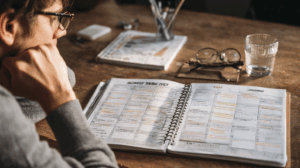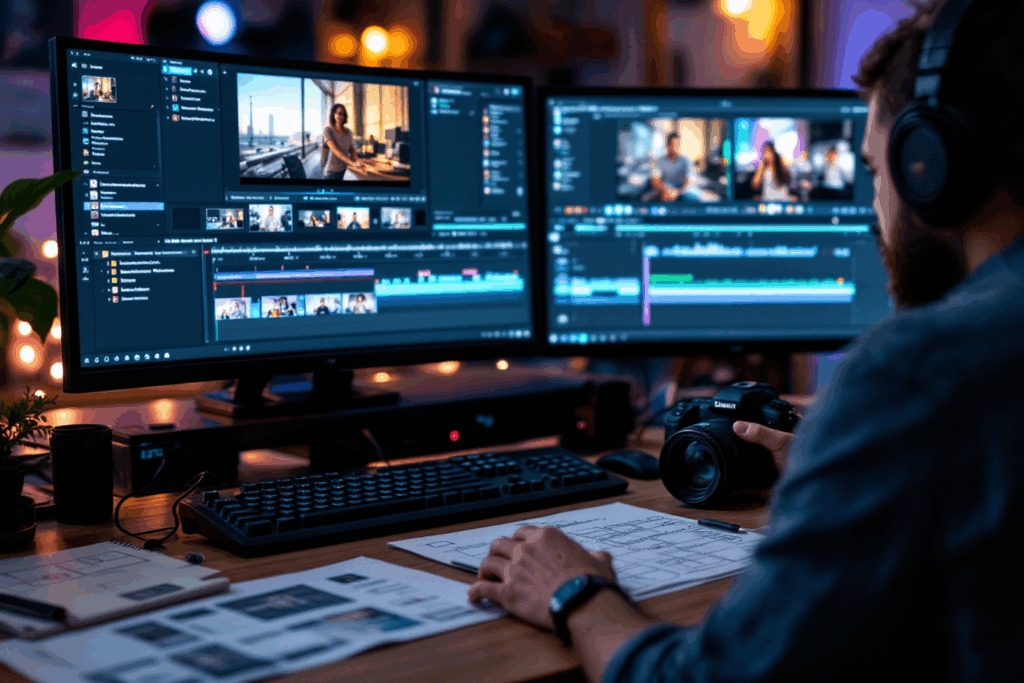
Future (Be going to) 3
English Blogs “Let’s Learn, Explore, and Connect to the World” Future (Be going to) 3 III. Uses of ‘Be Going To’ The ‘be going to’



 Anxiety, often misunderstood, can be a debilitating force that permeates every facet of one’s existence. It can cast a shadow over personal relationships, turning simple interactions into sources of stress. It can hinder professional performance, transforming daily tasks into insurmountable challenges. It’s not merely a case of nerves that can be shrugged off or easily conquered.
Anxiety, often misunderstood, can be a debilitating force that permeates every facet of one’s existence. It can cast a shadow over personal relationships, turning simple interactions into sources of stress. It can hinder professional performance, transforming daily tasks into insurmountable challenges. It’s not merely a case of nerves that can be shrugged off or easily conquered.
Contrary to common misconceptions, anxiety is a complex condition that demands understanding, patience, and a well-equipped toolkit for management. It’s not a fleeting emotion but a persistent state that can significantly impact an individual’s quality of life.
 This guide aims to shed light on the multifaceted nature of anxiety, providing a comprehensive exploration of strategies and tools to manage it effectively. It delves into both psychological and practical approaches, offering a balanced perspective on anxiety management.
This guide aims to shed light on the multifaceted nature of anxiety, providing a comprehensive exploration of strategies and tools to manage it effectively. It delves into both psychological and practical approaches, offering a balanced perspective on anxiety management.
From cognitive-behavioral techniques to lifestyle adjustments, this guide covers a wide range of strategies designed to alleviate the symptoms of anxiety. The statement focuses on the significance of mental health and highlights how controlling anxiety helps in promoting overall wellness.

By the end of this guide, you will be equipped with a diverse array of strategies and tools, each designed to tackle different aspects of anxiety. These tools will empower you to confront anxiety head-on, paving the way for a life characterized by calmness and centeredness.
In essence, this guide serves as a roadmap, guiding you through the complexities of anxiety towards a destination of improved mental health and a more peaceful life.
Anxiety is a condition that goes beyond just feeling stressed or worried. It is a pervasive state that can lead to significant distress and disrupt one’s ability to carry out day-to-day activities normally. It’s not a fleeting state of unease but a persistent and often overwhelming sense of worry that can make even the simplest tasks seem daunting.
Anxiety manifests in various forms, each with its unique characteristics:

Excessive and persistent worry about various daily matters is the defining feature of this type of anxiety. People with GAD may find themselves constantly worrying about health, money, family, or work, even when there are no signs of trouble.

Individuals with Panic Disorder experience recurrent, unexpected episodes of panic attacks. These attacks are sudden and involve strong feelings of fear, such as palpitations, a racing heart, or a fast heartbeat. They may also experience sweating, trembling, or shaking, as well as sensations of being short of breath, smothered, or choked. Finally, they may feel an overwhelming sense of impending doom.

Individuals with this condition experience intense fear, shame, or embarrassment when performing in social situations, which often leads them to avoid such situations or endure them with significant distress.
Understanding your anxiety is the first step toward managing it. This involves recognizing the patterns of your anxiety, identifying triggers, and being aware of how it affects your thoughts, feelings, and behaviors. It’s about observing your own reactions, understanding what exacerbates your anxiety, and acknowledging its impact on your life.
Knowing the root causes and symptoms of your anxiety can empower you to take the first steps toward developing strategies to manage it effectively. It’s about taking control of your life, not allowing anxiety to dictate your actions, but using your understanding of it to inform your responses and guide your journey towards better mental health. This understanding serves as the foundation upon which effective management strategies are built.

CBT is a widely recognized method for managing anxiety. It focuses on altering negative thought patterns that contribute to anxiety. Techniques involve identifying irrational beliefs and challenging them, developing problem-solving skills, and using relaxation exercises to manage symptoms. Engaging in CBT with a licensed therapist can provide tailored strategies to cope with anxiety. For those interested in self-guided CBT, there are resources and workbooks available that provide step-by-step guidance on how to apply these techniques in daily life. If you’re looking to learn about CBT principles and how they can be applied to manage anxiety, the following resources may be helpful to you.
Mindfulness encourages you to focus on the present moment, helping to reduce the impact of anxious thoughts about the past or future. Mindfulness frequently involves meditation, which requires sitting calmly and focusing on thoughts, sounds, breathing, or specific body parts. Regular meditation can decrease the body’s response to stress, reducing symptoms of anxiety. There are various forms of meditation, such as guided meditation, mindfulness meditation, and transcendental meditation, each offering unique benefits. Regular practice can help you develop a habit of mindfulness, allowing you to better manage your anxiety.

Physical activity can be highly effective in reducing anxiety. Endorphins are released when you engage in regular exercise, such as taking a brisk walk, practicing yoga, or participating in more rigorous activities like running or cycling. Endorphins act as both natural painkillers and mood boosters. Establishing a routine that includes physical activities can significantly reduce symptoms of anxiety. It’s important to choose an activity that you enjoy, as this will make it easier to maintain the routine. Even a short daily walk can have a positive impact on your mental health.
What we eat can affect how we feel. Consuming a diet that primarily consists of vegetables, fruits, lean protein, and whole grains can positively impact mental health. Some specific nutrients, such as omega-3 fatty acids which are commonly found in fish, magnesium that can be found in leafy greens, and vitamins B and D which can be found in fortified dairy products and cereals, have proven to be effective in reducing anxiety levels. Conversely, reducing intake of caffeine, alcohol, and sugar can also mitigate anxiety symptoms. Maintaining a balanced diet can provide your body with the necessary nutrients for optimal mental health.

Poor sleep can exacerbate anxiety, creating a vicious cycle. Keeping a regular sleep schedule, making your sleeping area comfortable, and steering clear of electronic devices before bed can enhance sleep quality and reduce anxiety. Developing a bedtime ritual, like reading a book or listening to soothing music, can communicate to your body that it’s time to sleep. To improve the quality of your sleep, it’s important to avoid consuming caffeine and eating heavy meals before going to bed.
A disorganized schedule can lead to stress and heightened anxiety. Establishing a routine and managing time effectively can help reduce these feelings. This includes setting realistic goals, breaking tasks into smaller steps, and scheduling time for relaxation and self-care. Using tools like planners or digital calendars can help you manage your time more effectively. Remember, it’s important to balance productivity with relaxation to prevent burnout and manage anxiety.

There are numerous apps designed to help manage anxiety. These apps offer features like guided meditation, breathing exercises, and mood tracking. Popular apps such as Headspace, Calm, and Moodfit provide resources to practice mindfulness, improve sleep, and monitor anxiety levels. These apps can be accessed anytime, anywhere, providing immediate support when anxiety strikes. They also allow you to track your progress over time, helping you understand your anxiety better.
Teletherapy has revolutionized mental health support by making it more accessible. Platforms like BetterHelp and Talkspace connect users with licensed therapists for video, voice, or text therapy sessions. This can be especially helpful for those with busy schedules or limited access to in-person therapy. These platforms often offer flexible scheduling and the ability to switch therapists if needed, ensuring that you can find the right fit for your needs.

Journaling can be a therapeutic tool for managing anxiety. Journaling your thoughts and emotions can clarify your understanding of them, help track triggers, and identify patterns in your anxiety. There are various formats that can guide this practice, including bullet journals, gratitude journals, and structured mental health journals. Bullet journals allow you to organize your thoughts visually, gratitude journals focus on positive aspects of your life, and structured mental health journals provide prompts to guide your writing.
Sensory tools can provide immediate relief from anxiety by grounding your senses. Stress balls and fidget spinners offer tactile stimulation that can help distract your mind from anxious thoughts. Weighted blankets apply gentle pressure across your body, mimicking the feeling of being hugged. This can help reduce symptoms of anxiety during high-stress moments and improve sleep quality.

Finding a community of individuals who understand what you’re going through can be incredibly comforting. Support groups, whether in-person or online, offer a space to share experiences, coping strategies, and emotional support with others facing similar challenges. These groups can provide a sense of belonging and help you feel less alone in your struggle with anxiety.
Beyond self-help tools and strategies, professional support from psychologists, psychiatrists, or licensed counselors is vital for many. Professionals in this field can design customized treatment plans to suit the unique needs of each individual, potentially including medication, therapy, or both. They provide professional advice and support to assist you in advancing toward better mental health.
Creating a personal anxiety management plan is a crucial step toward managing anxiety. This involves selecting strategies and tools that resonate with your lifestyle and preferences. Here’s how you can go about it:
1. Start Small: Begin by choosing one or two techniques to incorporate into your routine. This could be a mindfulness app, writing in a journal, or even few minutes of deep breathing. The key is to choose something manageable that you feel comfortable with.
2. Set Realistic Goals: It’s important to set achievable goals for implementing these techniques. For example, you might aim to use a mindfulness app for 10 minutes each day or write in your journal every night before bed. Remember, consistency is more important that perfection.
3. Consistent Practice: Consistency is key to seeing improvements. Make an effort to include these practices into your every day life as seamlessly as possible. This could mean setting reminders on your phone, practicing at the same time each day, or linking your anxiety management techniques to existing habits.
4. Track Your Progress: Consistently check in with yourself to see how you’re doing. You might find it helpful to rate your anxiety levels each day or note down when you’re feeling particularly stressed. This can help you see how your anxiety changes over time and identify any patterns.
5. Be Open to Adjustments: What works for one person may not work for another, so it’s important to be flexible. If a certain technique isn’t helping, don’t be afraid to try something else. Remember, this is a personal journey, and it’s okay to make adjustments along the way.
6. Celebrate Small Wins: Every small step you take towards managing your anxiety is a victory, no matter how small. Celebrate these moments – they’re a sign of your progress.
7. Be Patient with Yourself: Navigating the path to managing your anxiety can be challenging. Be patient with yourself, and remember that it’s okay to have bad days. The important thing is that you’re taking steps towards better managing your anxiety.
Managing anxiety is a process that requires effort and time, it is not a one-time achievement. The key is to discover the methods that work best for you and incorporate them into your daily routine. With persistence and regularity, you can make considerable progress in handling your anxiety.
 Managing anxiety is indeed a continuous journey. It’s not a destination but a path that you walk every day. This journey may be filled with challenges, but it’s important to remember that these challenges do not define you. They are merely obstacles that you have the strength to overcome.
Managing anxiety is indeed a continuous journey. It’s not a destination but a path that you walk every day. This journey may be filled with challenges, but it’s important to remember that these challenges do not define you. They are merely obstacles that you have the strength to overcome.
 The right strategies and tools can make a significant difference in this journey. Psychological approaches like cognitive-behavioral therapy can aid in understanding and altering thought patterns that contribute to anxiety. Physical strategies, including regular exercise and a healthy diet, can reduce the physical symptoms of anxiety. Lifestyle strategies, such as mindfulness and meditation, can help you stay present and focused, reducing anxiety’s impact on your day-to-day life.
The right strategies and tools can make a significant difference in this journey. Psychological approaches like cognitive-behavioral therapy can aid in understanding and altering thought patterns that contribute to anxiety. Physical strategies, including regular exercise and a healthy diet, can reduce the physical symptoms of anxiety. Lifestyle strategies, such as mindfulness and meditation, can help you stay present and focused, reducing anxiety’s impact on your day-to-day life.
In addition to these strategies, there are numerous digital and physical tools available to assist you. Digital tools, like mental health apps, provide resources and community support at your fingertips. Physical tools, such as journals or stress balls, can provide a tangible outlet for your anxiety.
 Keep in mind that seeking professional assistance when necessary is not an indication of weakness, but a demonstration of strength. It requires bravery to ask for help. Therapists and counselors are trained experts who can offer you more strategies and tools to cope with your anxiety.
Keep in mind that seeking professional assistance when necessary is not an indication of weakness, but a demonstration of strength. It requires bravery to ask for help. Therapists and counselors are trained experts who can offer you more strategies and tools to cope with your anxiety.
As you implement these practices into your daily life, it’s important to hold onto hope. Managing anxiety is not only possible, but it’s within your reach. Each step you make on this path is a move toward better mental health and overall well-being. Each day is an opportunity for growth and healing. So, keep going. Keep growing. And remember, you are not alone on this journey. You are strong, you are capable, and you can manage your anxiety. This is not just a conclusion but a beginning of your empowered journey towards greater mental health and well-being.

English Blogs “Let’s Learn, Explore, and Connect to the World” Future (Be going to) 3 III. Uses of ‘Be Going To’ The ‘be going to’

English Blogs “Let’s Learn, Explore, and Connect to the World” Past Continuous 4 IV. Forming Questions and Negatives in the Past Continuous The ability to

Laugh and learn with ‘Comic Collections’ by Cassia North – a delightful dive into everyday conversations in professional and casual settings, now in a vibrant, humor-filled ebook. Perfect for all ages!



